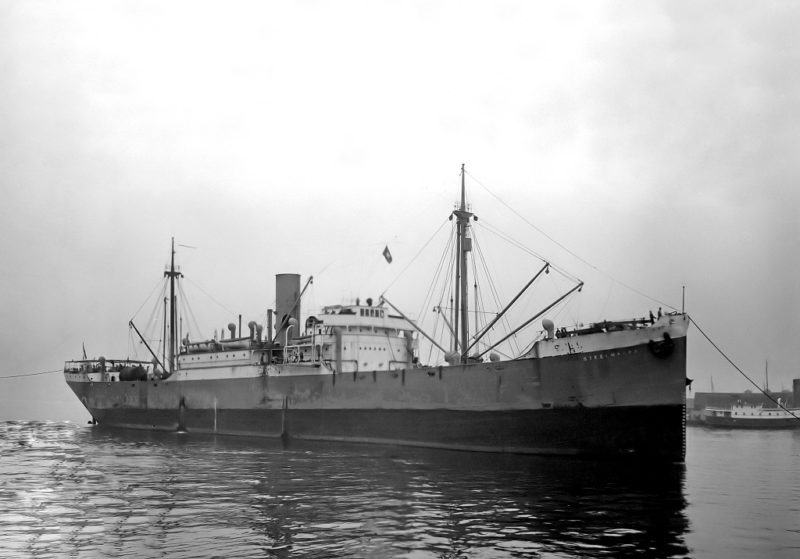
During the 1950s and 1960s, especially during those years when the Vietnam conflict was building towards its zenith, it was not uncommon to see an American ‘Victory’ or ‘C3’ freighter belonging to Isthmian Steamship Company, or in later years, State Marine Lines in any of the major South East Asian Ports.
Isthmian Steamship Co. with its black hull and yellow funnel, or States Marine Lines freighters, with States Marine Lines painted on their grey hulls and their red, white, and blue funnels. Isthmian Steamship vessels were integrated into the States Marine Lines fleet after 1956 when they bought out Isthmian, which included their ships.
The company heralds from the U.S. Steel Corporation and was founded by James A. Farrell in 1910. Farrell’s connections with the maritime industry stem from his father who was a Master Mariner.
In 1910, James A. Farrell was appointed President of the U.S. Steel Corporation. Through Farrell’s friendship with J.T. Lilly, a senior manager in the New York office of Norton & Co., one of the most prominent Shipping Agents and Brokerages in New York at the time, Farrell began to fix his steel cargos and chartered ocean going vessels to carry his steel products. Eventually, realizing the significant savings that could be made using their own ships to transport their steel cargoes, led to the founding of his own British flag shipping company. Farrell’s New York agents worked very closely with the British Bucknall Brothers and Federal Steam Navigation Co., which led to the establishment of Isthmian Steamship Company Ltd. The new shipping concern was registered in London and so named to celebrate the completion of the Panama Canal by American interests, scheduled for 1914.
Isthmian Steamship Co. Ltd., of 2 Fenchurch Avenue, London was established by U.S. Steel Corporation with a capital of £100,000, to operate under the British flag, to operate its own vessels and others it chartered to meet needs. Isthmian was a wholly owned British subsidiary of U.S. Steel Products Export Co. Federal Steam Navigation Co., whose history dated back to 1782, was also located at 2 Fenchurch Avenue and managed Isthmian’s one ship. In the United States management was awarded to the Norton Lilly Agency, Mr. J.T. Lilly having been made a partner of the firm by this time.
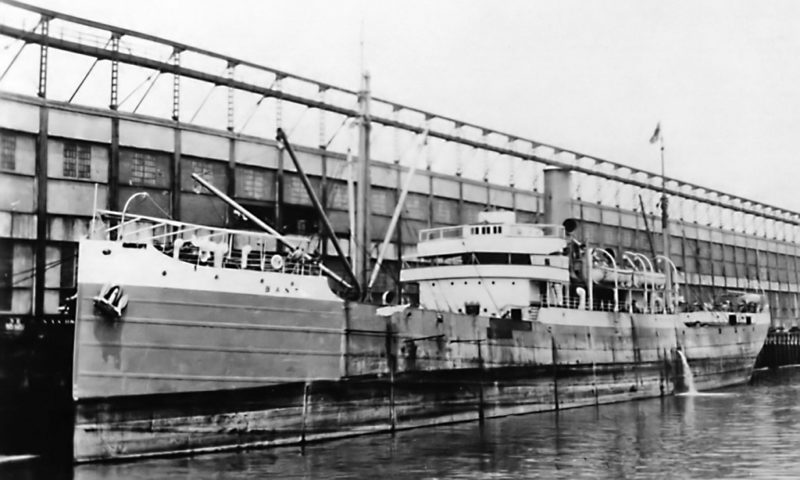
In January 1936 the Bessemer City of Isthmian Lines was stranded off the coast of Cornwall, near St. Ives, whilst on a voyage from New Westminster to London, carrying general cargo. All 33 onboard were rescued with no loss of life. The vessel broke in two and became a total loss. This vessel had oil fired furnaces, electric lighting, and radio. It was a sad loss.
The Line loaded the parent company’s steel cargoes for India, returning with profitable jute and burlap on the return voyage. The Isthmian Steamship Company worked closely with the well-known British Ellerman Lines, which secured the return cargoes from India in exchange for a percentage of the of the steel cargo produced by U.S. Steel. During its first years Isthmian operated various tramp vessels, because the ships sailed to ports anywhere in the world, as and when steel had to be carried.
Isthmian’s first ship was the SS Bantu, a British vessel launched in 1902 and purchased by U.S. Steel in 1907 for a reputed £24,000. By 1914, the company had purchased six additional ships, Kentra, Buenaventura, Santa Rosalia, Charleton Hall, Craston Hall and Crofton Hall, all rugged British tramp steamers.
With the outbreak of World War 1 however, all British flagged ships were requisitioned by the Admiralty for war service. This brought about the demise of the London based company. A new company was formed, United States Steel Products Co. in New York. Farrell reflagged the ships to the American register, due to the fact, that America was not engaged in hostilities at the commencement of the War.
The line had its first mention in Asia, at Hong Kong in January 1912, with advertisements to consignees in the South China Morning Post with the line advertising for cargo which is a clear indicator that the company had established a trading route to the Far East by this time. However, it is understood that the main focal point in Asia at that time was a scheduled service to the Philippines.

The next occasion on which the company advertised for cargo from Hong Kong was in 1931, by which time the Bank Line had taken over as representing agents.
In January 1930 Isthmian Steamship Company was organized separately from U.S. Steel which retained the ships Steel Chemist, Steel Electrician, Steel Motor, and Steel Vendor. Isthmian Steamship Company acquired the following ships:-
Anniston City, Crofton Hall, Mobile City, Steel Exporter, Atlanta City, Chattanooga City (sunk by U-606 on 20th February 1943), Steel Seafarer 1921-1943 (sunk by seaplane in 1943), Steel Traveler 1922-1944 (sunk by a mine in 1944), Steel Inventor 1920-1954 (collided with and sunk USS Woolsey in 1921), Steel Scientist (operated as the transport ship Sea Owl from 1944 until 1947), Steel Trader, Steel Voyager, Memphis City, Montgomery City, San Francisco, Steel Age, Steel Engineer, Steel Mariner, Tuscaloosa City, Bessemer City, Birmingham City, Ensley City, Knoxville City, Steelmaker, Chickasaw City, Fairfield City, Steel Ranger, Steel Worker, and Selma City.
The 5,686grt Sea Marlin was purchased in 1947, renamed the Steel Director, and operated until sold to the States Marine Lines in 1956, where she continued operating under the same name until scrapped in 1971.
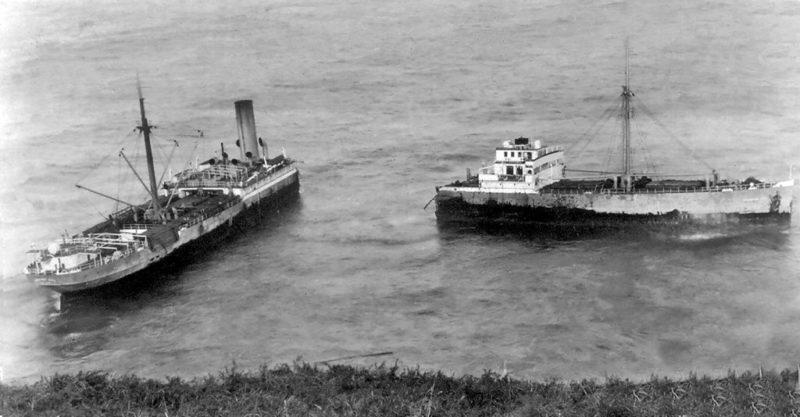
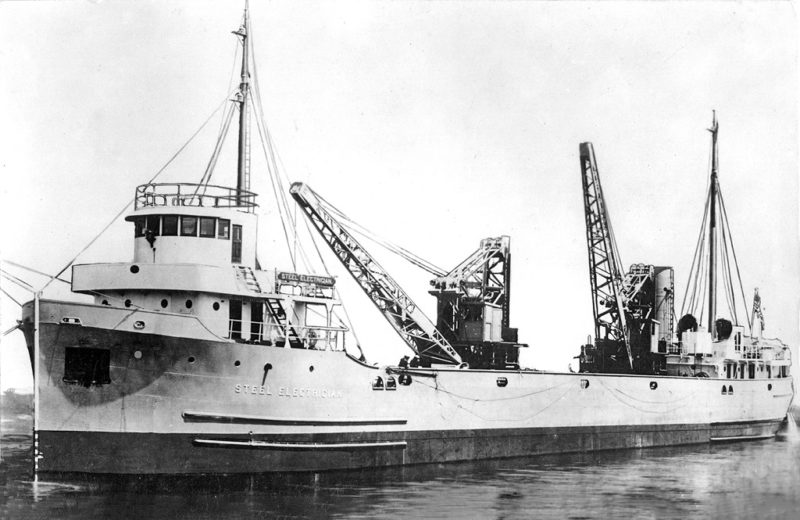
It would appear, that calls to Hong Kong at this juncture depended solely on cargo inducement although the company regularly received editorial in the South China Morning Post until the outbreak of World War 2 in 1939.
With the occupation of Hong Kong by the Japanese in 1941, obviously all trade ceased with the colony.
Postwar, the first mention seems to be in 1948 when there was a consignment advertisement with local agents Gilman & Co., a long established, business in Hong Kong, who were to remain as agents through to the advent of containerization in 1969, and the demise of the company in the mid-1970s

The Isthmian Steamship Company would continue to expand its operations in the ensuing decades, helped by being awarded significant American Government contracts at the conclusion of World War 2.
Their vessels were some of the first to be fitted with Gyro Compasses, due to the effects of steel cargoes on standard magnetic compasses, but U.S. Steel began to have doubts about keeping its own fleet of vessels, partly because steel cargoes were dwindling, due to competition, as other countries set up their own steel mills and progressively began to supply many traditional markets, and neighbouring countries with steel products.
Due to internal reasons in the mid-1950s, U.S. Steel began to seek a buyer for its fleet. In 1956 Isthmian Steamship Company, by now operating some 24 vessels, and which had changed its corporate identity to “Isthmian Lines Inc.” earlier in the year, was sold for an estimated $30 million to the States Marine Corporation.
In hindsight, U.S. Steel had made a good commercial decision in disposing of its ageing fleet, thereby avoiding altogether the necessity to acquire more modern tonnage. U.S. Steel deciding to sell off the company on the basis that Isthmian’s overall usefulness had outlived itself, as it now carried only a small percentage of the corporation’s steel cargo exports. Advertisements in Hong Kong for cargo on the line’s ships seem to end in around 1962, which is likely to do with the line having been sold to States Marine.
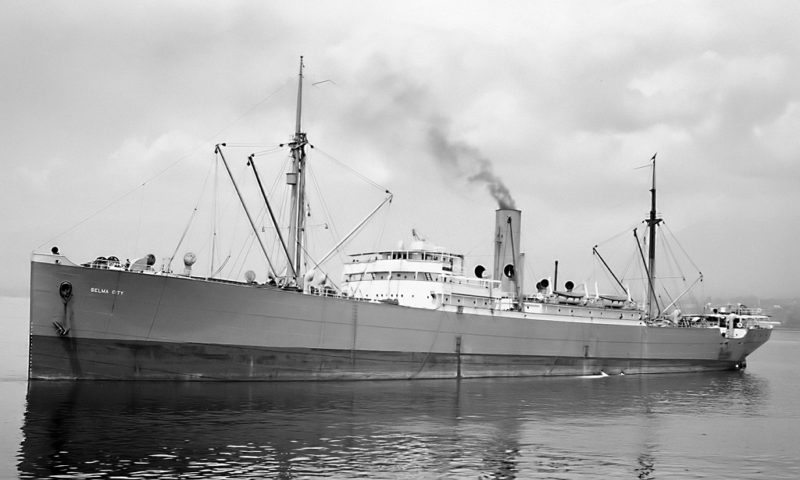
Reviewing fleet records right up until its demise in 1970s, it appears that the company had a long history of incidents and mishaps during its tenure in shipping.
Below is a typical vessel’s history, of incidents and events, for Isthmian’s Steel Admiral whilst under their ownership.
It makes colourful reading:-
20/9/48:
On voyage Baltimore to Ras Tanura, aground at 0200 in Suez Roads for entire length of ship off Marakeb Quay at Port Tewfik. Tug Hercules unable to refloat ship, fuel, water and 300 tons cargo unloaded.
24/9/48:
With 1,750 tons of cargo offloaded, refloated at 1530.
10/48:
Propeller hit by barge #113.
11/48:
Stevedore damage to boom and hold sheathing.
23/2/49:
Mine exploded 50 yards from ship in Saigon River about 40 miles from Saigon, no damage.
4/50:
Struck dock. Repairs to propeller and renew shaft with spare.
5-6/11/50:
Heavy weather, renew port accommodation ladder, partially renew platform and gangway.
1/4/51:
Damage discovered in drydock at Baltimore, date, and cause unknown. Renew rope guards, partially renew propeller sealing glands, draw shaft, and repair sundry damages.
20/10/51:
Struck submerged object.
21/4/52:
While manoeuvring at Port Swettenham, scrapped SS Queen Anne at dock, stanchion, bulwark, and pipe damage.
7/4/54:
Damage to starboard boiler caused by alleged crew negligence.
5/8//54:
From boiler damage 7/4/54, renew 88 screen tubes, 29 water wall and 885 generating tubes and brickwork partially renew, together with
sundry damages and extensive removals.
27/8/56:
Collision with barge Barz in tow of tug Tooserkan while moored at Bandar Shahpur.
29/8/56:
Radio message received from Master of Steel Admiral, of serious propeller damage when leaving Bandar Shahpur, inflicted by tug and barge attending another vessel. It was understood the vessel was diverting to Bahrein.
5/9/56:
Arrived Bahrein for survey of damage and repair if possible, reported 2 blades of propeller bent 12 inches deep at top. Sailed for Dammam.
27/2/57:
From collision with barge Barz and tug Tooserkan 27/8/56, remove and recondition propeller, tailshaft fractured, renew, coupling bolts renew, together with sundry damages and removals, repairs completed at Brooklyn.
8/3/57:
Steel Admiral, collided in New York harbour with small motor tanker VAL-T in driving rain. Steel Admiral has gash 4 ft. by 8 ft. on starboard side above the waterline. VAL-T reported to be sinking. Seven Coast Guard vessels were sent to the scene of the collision in upper New York Bay, near The Narrows, the channel between Brooklyn and Staten Island. Coast Guard said the tanker’s bow was reported stove in and a big hole was stated to have been ripped in the side of the freighter, which had been at anchor. A small water taxi was sent to take members of the crew ashore from the freighter was crushed at the time of collision. The one man killed was identified as the pilot of the water taxi. The Steel Admiral lowered a power lifeboat which towed the water taxi to shore before it could sink. Both vessels were towed to shipyards in New York
14/3/57:
From collision 8/3/57, 1 starboard side shell plate renew, 2 partially renew and 1 fair, frames, deck stringer plate, deck beams and brackets straighten and partially renew, extensive removals and replacements, refrigeration space insulation, together with sundry damages, drydocking and repairs at Brooklyn.
5/12/57:
Damaged as consequence of soot fire in the port boiler economizer while lying at Pier 32, Honolulu.
23/1/58:
From boiler damage 5/12/57, 4 economizer elements renew, baffles renew, soot blower element renew, brickwork partially renew, casing panel plates partially renew, insulation partially renew, together with sundry damages and removals, repairs at Baltimore.
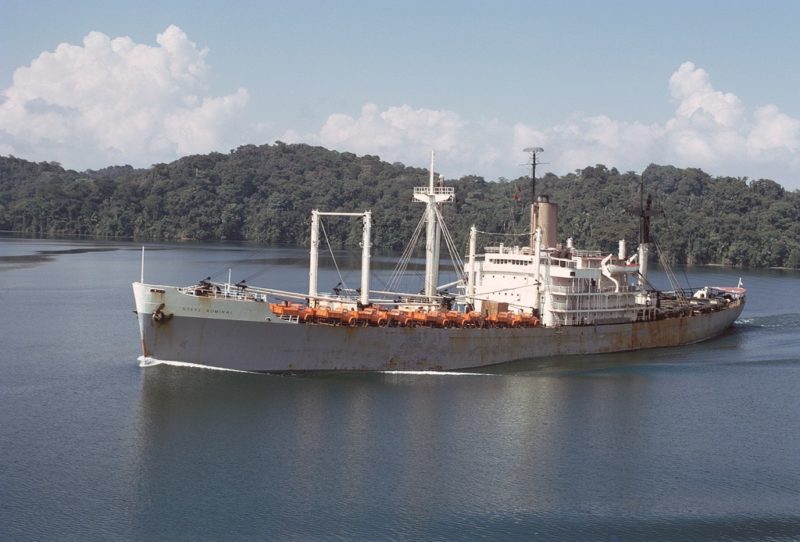
16/9/62:
From Bangkok, steamer Steel Admiral, Baltimore for Penang, grounded at 10:05am outside Bangkok bar. Vessel refloated under own power at 4:45pm and sailed for Surabaya, no damage reported.
14/3/62:
Steel Admiral, Philadelphia for Penang, damaged due to alleged stevedore negligence in damaging No. 3 starboard double bottom tank top manhole cover while loading cargo at Brooklyn.
15/3/62:
Damage discovered in No. 3 lower hold flooded with fuel oil, including 400 tons of steel oil drums and packaged vegetable oil. Cargo removed, cleaned and re-stowed, lower hold cleaned, tank manhole cover renewed, together with sundry damages and removals. Repairs completed.
2/6/63:
Struck dock while berthing at Sihanoukville, Cambodia.
5/6/63:
From damage alleged sustained 16/9/62, as consequence of stranding at Bangkok Bar while en route from Bangkok to Surabaya, propeller recondition, tailshaft draw for examination, tailshaft recondition, inner stern bearing re-wood, spare tailshaft and propeller install, centre and lower rudder pintles re-machine and pintle bushings renew and rudder side plating fractures weld, together with sundry damages and removals. Repairs completed at Baltimore.
26/10/63:
At Singapore, collided at 5:21pm with motor vessel Pundua when Pundua was leaving the Empire Dock.
28/4/65:
Damage discovered in consequence of striking and/or landing heavily against a pier or dock.
5/18/65:
From damage alleged sustained on 2/6/63 as consequence of striking the dock while berthing at Sihanoukville, Port side shell four plates renew and one fair, internals straighten and partially renew, sheathing and insulation in way remove and partially renew, together with sundry damages and removals. Repairs completed.
24/3/67:
Damaged as consequence of striking dock at Dundalk Marine Terminal, Baltimore.
11/10/67:
Steamer Steel Admiral has sustained engine breakdown in South China Sea on voyage to South Vietnam.
13/10/67:
Steamer Steel Admiral, advised vessel now proceeding under own power, breakdown rectified and should arrive Saigon 14/10 or 15/10.
27-29/5/68:
Damaged striking pier at Sattahip.
27/6/68:
From San Francisco, steamer Steel Admiral, damage alleged sustained, 24/3/67 from striking dock at Baltimore. Four shell plates to renew and two to crop and partially renew, ship side insulation in No. 4 hatch port and starboard ‘tween deck chambers to remove and replace after repairs, together with sundry damages and removals, repairs deferred.
6/5/69:
From Hong Kong, Steamer Steel Admiral, surveyor advises found starboard side shell plating H and G in way of No. 4 cargo hold heavily set in between frames 1361/2 and 1501/2, port side shell plating H and G in way of No. 4 cargo hold heavily set in between frames 1251/2 and 1501/2 and starboard side shell plating H 13 in way of No. 3 cargo hold set in moderately. All stated due to striking pier at Sattahip 27-29/5/68. Repairs being carried out at Hong Kong. Drydocking not necessary.
4/9/69:
The following message has been received from Hong Kong, steamer Steel Admiral, U.S. for South Vietnam, full cargo of lumber, asphalt, beer and machinery, breakdown lat. 19º 2′ N, long. 117º 42′ E. Tug Taikoo proceeding in evening of 9/4/69, Hong Kong time. From Yokohama, Steamer Steel Admiral, on loaded passage from U.S. West Coast to Da-Nang, disabled due to boiler trouble in position lat. 19º 21′ N, long. 117º 42’ E, approximately 250 miles south-east of Hong Kong and 105 miles from Pratas Reef. Master requests tug assistance and suitable tug available Hong Kong.
6/9/69:
Steamer Steel Admiral taken in tow at 8 AM, JST, 6/9/69, by Tug Taikoo, estimated date of arrival at Hong Kong 8/9/69, terms believed
daily rate.
10/9/69:
From Hong Kong, steamer Steel Admiral, Lloyds instructed by owner’s agents and surveyor advises port and starboard boilers out of action and header handhole doors removed. Stated cause header handhole door joints leaking badly and unable to maintain working water level in boilers. Crew unable to effect necessary repairs.
28/12/70:
Steel Admiral, New York for Yokohama, and Saigon with general cargo, arrived Cristobal for boiler repairs.
8/11/71:
Alleged sustained damage to tailshaft, discovered in November when vessel was drydocked at Hoboken, N.J. where repairs were carried out.

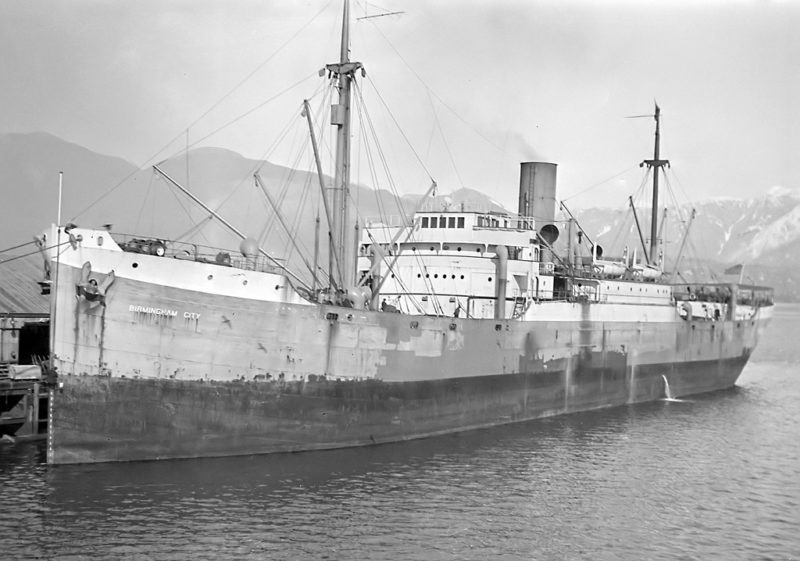
The addition of Isthmian’s 24 vessels made States Marine the largest unsubsidised U.S. flag carrier which came close to challenging U.S. Lines in size and tonnage.
Henry Mercer, who was the president of States Marine, predicted an increasing demand for U.S. flagged tonnage, and the purchase of Isthmian quickly secured them a readily available fleet, to supplant their heavy use of time chartered ships.
Not only did they acquire the ships but also Isthmian’s world-wide network of agents, cargo sources and contacts with a reputation for service unexcelled in American international merchant shipping circles. On 1st December 1970, Henry D. Mercer retired as Chairman, and devoted his retirement to his love of ocean yacht racing.
The Mercer family and other major investors began to sell their investments in States Marine Lines in 1971.
States Marine Lines continued to operate as a wholly owned entity of States Marine until the early 1970s, mainly using war surplus standard American built, Liberty, Victory, C2, C3 and C4 types.
The final four war standard types were scrapped at Kaohsiung between April and September 1973 in Copper State, Pine Tree State, Gopher State and Buckeye State. However, a subsidiary company still owned five ore/oil carriers as Tankore Corporation, set up in 1968 as a subsidiary of Global Bulk Transport Inc.
Three ore/oil carriers completed at the Fairfield yard at Govan during the 1950s for management by Gorrissen and Klaveness of Oslo had been purchased and renamed Sanovia (built as Free State), Santurce (built as Enduro), and Santos (built as Cuyahoga). They served for three years from 1972 to 1975, with Sanovia and Santurce scrapped, and Santos sold for use as a pipelayer and crane ship and renamed Ocean Builder 1. Two sister ore/bulk/oil carriers of 46,935 dwt had been commissioned as newbuildings in Japan in 1967/68 as Weatherly and Buckeye, and were the last vessels of the States Marine Lines empire when they were sold off in March and August 1979.
They were sold to the Chateaugay Corporation of Panama without change of name and continued to trade in American coastal waters until sold in 1983 to Trade Hellenic Inc., taking the names of Trade Quest and Trade Daring.
States Marine Lines had suffered from a complete lack of subsidy in competition with many other subsidised American lines.
Its last listed corporate office is dated 1974. when the company, as with many American steamship companies of this era, failed to transition into bulk and containerized cargo, requiring replacement of the fleet with new vessels, and therefore ceased to trade as a direct consequence.
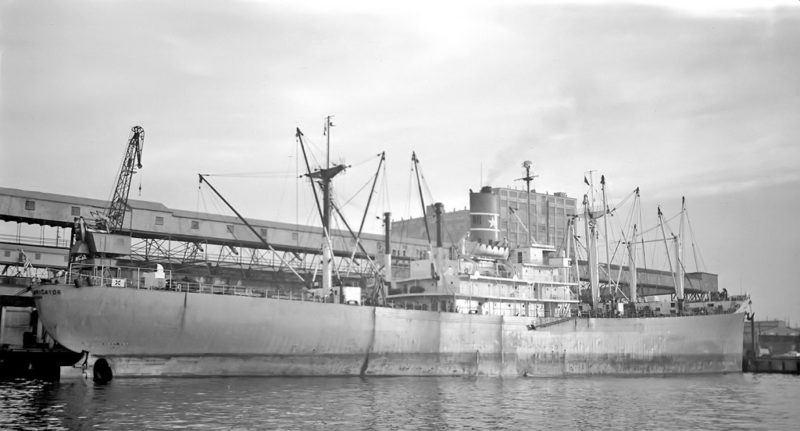
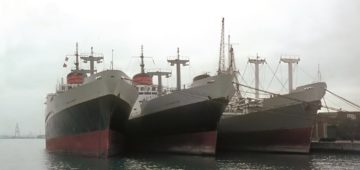



Comments
Sorry, comments are closed for this item